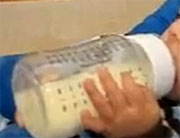
THURSDAY, May 5 (HealthDay News) — While new mothers are strongly encouraged to breast-feed their babies for at least a year, a small study of child-care centers suggests that relatively few are set up to help moms to do so.
The research, led by doctors at Cincinnati Children’s Hospital Medical Center, revealed that only 12 percent of infants enrolled in child-care centers in two counties near Cincinnati were being fed their mother’s milk, even though 96 percent of the center directors said they’d be comfortable facilitating the practice.
“We were surprised to find that despite the high staff comfort levels in feeding human milk, only a small percentage of infants were being fed human milk,” said study author Dr. Kristen Copeland, an assistant professor of pediatrics at Cincinnati Children’s Hospital Medical Center.
One big stumbling block seems to be a lack over overnight refrigerated storage at centers for any pumped breast milk mothers might care to leave, the study found.
“We know that centers that allow pumped milk to be stored overnight make it easier for women to provide a constant supply of milk for their babies,” Copeland said, “so if more centers offered overnight storage, it might increase the number of infants who are fed human milk.”
The findings were presented this week at a joint meeting of the Pediatric Academic Societies/Asian Society for Pediatric Research in Denver.
According to the researchers, roughly half of all infants in the United States are in child care, and 18 percent are in centers.
For the study, Copeland and her colleagues conducted telephone surveys with the directors of 167 child-care centers in two urban counties in southwestern Ohio. The directors were asked how many infants currently enrolled at their centers were being fed pumped breast milk, how comfortable the center was with feeding pumped breast milk, and if the center provided a refrigerator or freezer where mothers could store pumped breast milk overnight.
Only 26 percent of the centers said human milk could be stored overnight.
Three factors — allowing parents to store human milk overnight, a primarily white enrollment, and a smaller proportion of babies receiving subsidized tuition — seemed to raise the odds that babies cared for at a center might receive their mother’s milk, the researchers found.
Copeland said that although the study didn’t examine the reasons why so few infants received bottles of pumped breast milk while at day care, a lack of overnight storage might be a key contributing factor.
The low prevalence of human milk feeding among non-white and low-income infants, especially, might also “reflect lower breast-feeding initiation rates or women’s limited options for pumping in the workplace,” the authors noted.
“The findings speak to the tremendous challenges that women face in being able to successfully breast-feed their babies,” said breast-feeding researcher Dr. Alison Stuebe, an assistant professor of obstetrics and gynecology at the University of North Carolina School of Medicine in Chapel Hill.
Stuebe agreed that the differences seen between babies from poorer or more affluent homes might be due, in part, to mothers not being able to pump during the workday. “The higher your income, the more likely it is that you have an office with a door that you can close for twenty minutes so you can pump,” she said. “If you’re working at the drive-through window of a fast-food restaurant, you don’t have that option.”
Child-care centers that want to be truly cooperative need to do more than just provide overnight storage for pumped milk, Stuebe noted. “For instance, there should also be a comfortable place where mothers can sit down and nurse their babies, either at lunchtime or when they come to pick them up at the end of the day,” she said.
More information
For more on breast-feeding, go to the National Women’s Health Center.

